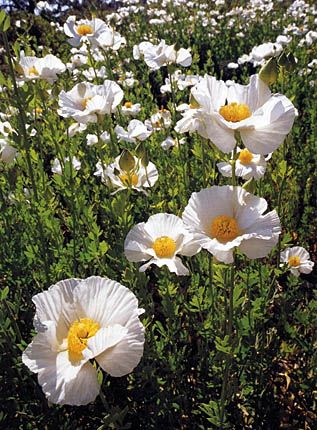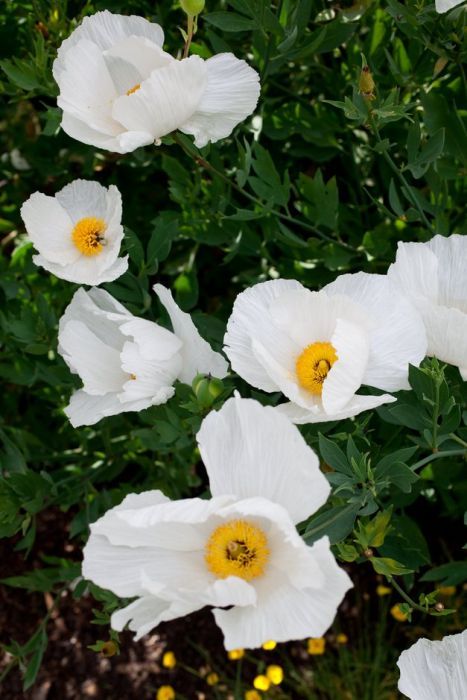Romneya coulteri

Romneya coulteri, commonly known as Matilija Poppy or Fried Egg Plant, is a spectacular perennial herbaceous plant native to California and Baja California.
Admired for its large, showy flowers resembling fried eggs, adds a touch of grandeur to gardens and natural landscapes.
In this comprehensive article, we will explore the botanical intricacies, habitat preferences, life cycle, ecological and cultural importance, conservation status, and care guidelines for Romneya coulteri.
Botanical Description
Is a member of the poppy family (Papaveraceae) and is known for its striking appearance.
It typically grows to heights of 4 to 7 feet, with tall, erect stems adorned with gray-green, deeply lobed leaves.
The most distinctive feature of Matilija Poppy is its large, solitary flowers, which can measure up to 9 inches in diameter.
The flowers have crinkled, crepe-like petals that are pure white with a prominent golden-yellow center, resembling fried eggs hence the common name.
Flowering occurs in late spring to early summer, and individual flowers last for several days before wilting.
The plant spreads via rhizomes, forming clumps over time.
Habitat and Distribution
Is native to the coastal regions of southern California and northern Baja California, where it inhabits a variety of habitats including chaparral, coastal sage scrub, and oak woodlands. It thrives in sunny locations with well-drained, sandy or loamy soil.
Matilija Poppy is often found growing on slopes, along roadsides, and in disturbed areas where it adds a dramatic flair to the landscape.
While native to specific regions, Matilija Poppy has been cultivated and naturalized in other temperate regions with similar growing conditions.
Life Cycle and Phenology
As a perennial plant, Matilija Poppy exhibits a relatively long life cycle compared to annuals. Growth typically begins in late winter to early spring, with new shoots emerging from underground rhizomes.
Flowering peaks in late spring and early summer, with individual flowers blooming successively along the stems.
After flowering, seed pods develop and eventually split open to release numerous tiny seeds.
Matilija Poppy may go dormant in hot, dry summer months, re-emerging with the onset of cooler temperatures and autumn rains.
Ecological and Cultural Importance
Matilija Poppy plays a significant ecological role in its native habitat, providing food and habitat for a variety of wildlife species.
The large, showy flowers attract bees, butterflies, and hummingbirds, which pollinate the flowers and facilitate seed production.
Additionally, the plant's dense foliage provides cover and nesting sites for birds and small mammals.
Culturally, Matilija Poppy has been celebrated for its beauty and has inspired artists, poets, and gardeners alike.
Its majestic flowers and graceful foliage make it a popular choice for ornamental gardens, native plant landscapes, and naturalistic settings.
Conservation and Threats
While Matilija Poppy is not currently listed as threatened or endangered, it faces conservation challenges due to habitat loss, urbanization, and invasive species.
The expansion of urban areas, agriculture, and infrastructure development has led to the destruction and fragmentation of natural habitats where Matilija Poppy once thrived.
Additionally, competition from invasive plant species, altered fire regimes, and climate-related factors such as drought and increased temperatures further threaten Matilija Poppy populations.
Conservation efforts focused on habitat preservation, restoration, and public education are essential for ensuring the long-term survival of this iconic California native plant.

Caring for Romneya coulteri
Sunlight
Plant Matilija Poppy in a location that receives full sunlight, as it thrives in bright, sunny conditions.
Watering
Provide regular watering during the plant's active growing season, especially during periods of drought.
However, be cautious not to overwater, as Matilija Poppy is drought tolerant once established.
Soil
Plant in well-drained, sandy or loamy soil with good drainage.
Avoid heavy clay soils, which can cause root rot and other problems.
Pruning
Deadhead spent flowers regularly to promote continuous blooming and prevent self-seeding.
Cut back any dead or damaged foliage as needed to maintain plant health and appearance.
Mulching
Apply a layer of organic mulch around the base of the plant to help retain moisture, suppress weeds, and regulate soil temperature.
Avoid covering the crown of the plant with mulch to prevent rot and fungal diseases.
Support
Matilija Poppy may benefit from staking or other support structures, especially in windy locations or when grown in rich soil that promotes vigorous growth.
Follow these care guidelines to cultivate robust Matilija Poppy plants, enhancing California's natural landscapes and conserving native species.
Whether for ecological, cultural, or ornamental purposes, Matilija Poppy's majestic flowers and enduring charm will captivate.
Leave a Reply
You must be logged in to post a comment.